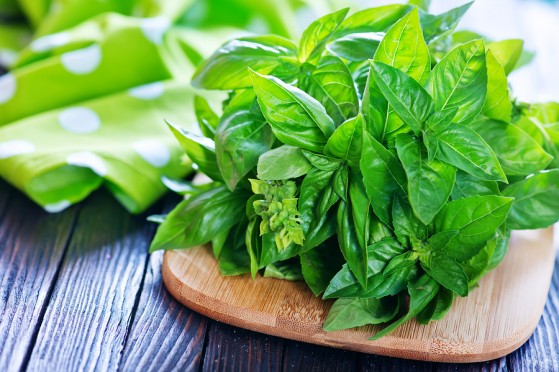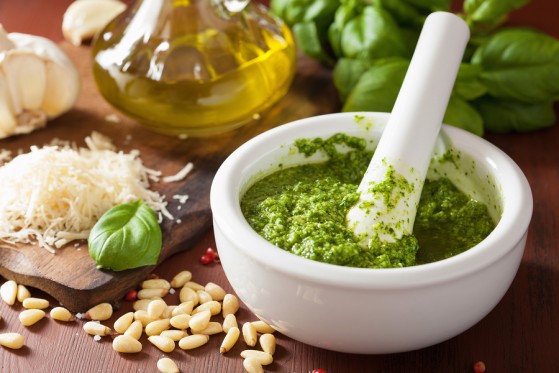Spices Of Life: Health Benefits Of Basil.

{source}
“The good man suffers but to gain,
And every virtue springs from pain;
As aromatic plants bestow
No spicy fragrance while they grow;
But crush’d or trodden to the ground,
Diffuse their balmy sweets around.”
~ Oliver Goldsmith
History of Basil
Basil: Ocimum basilicum
Common varieties include: pupurascens, citriodorum, minimum, and sanctum
Basil is an annual aromatic that is native to Pakistan, Afghanistan and India. Its leaves, which are the most commonly used portion of this herb, are shiny and oval, sometimes with ruffled edges, depending upon the variety. Basil can be grown in almost any location, including indoors.
Historically, basil has been touted as one of the most powerful and sacred herbs, revered by ancients and still highly incorporated into modern use. Long-standing lore surrounding this aromatic herb attests that by planting and/or placing basil on burial sites, one can aid the deceased in gaining swift entrance into heaven and other desired realms of the afterlife. Some sources even purport that basil grew at the site of Christ’s crucifixion.
Strangely, there is a good deal of folklore suggesting that basil is a source of protection from scorpion stings while simultaneously having the power to incite the spontaneous growth of scorpions within the brain. Regardless of the validity of these tales, basil is still associated with the sign of Scorpio in astrology.
Some of the earliest references to basil date back to the 2nd century BCE when Chrysippus noted its power to drive men insane. Others wrote of the basil plant’s ability to cure melancholy and procure a happy heart. Basil is prominent in Hindu tradition, having said to have grown from the ashes of Tulsi, after her death, the plant thus earning the same name.
Basil remains a medicinal and religious symbol in many places around the globe, and enjoys a longstanding reputation as a plant of love, purification, protection and eternal life. Even today, tulsi, or basil, is used as an additive to food and water aimed at preventing germination of bacteria, and as a general antidote to several poisons.
Considered a powerful aphrodisiac as well, young women were once encouraged to place a pot of basil on a window sill or terrace, for its ability to help lure and retain lovers.
“A man taking basil from a woman will love her always.” ~ Sir Thomas Moore
Healing Properties of Basil
Basil, like many other herbs, has a variety of uses, both medicinal and culinary. A member of the mint family, basil contains essential oils that have been found to have insecticidal, antibacterial, antimicrobial and mild antibiotic effects. The leaves and flowering tops are the most useful parts of the plant, and contain estragol, eugenol, tannins and basil camphor.
Commonly recognized medicinal properties of basil include:
- Antidepressant
- Anti-inflammatory
- Antispasmodic
- Expectorant
- Anti-emetic
- Anti-itch
- Analgesic
- Lowers blood sugar
- Antipyretic
- Adrenal cortex stimulation
Indications for use of basil may include:
- Anxiety
- Depression
- Congestion, cough and colds
- Colic
- Constipation
- Sore throat
- Indigestion
- Bites and stings
- Headache
- Digestive disorders
- Menstrual cramps
- Lethargy and tiredness
Many consume raw basil leaves before meal time to stimulate appetite, or after a meal to help aid in digestion while preventing gas and bloating.
Basil is considered effective in Chinese medicine for renal issues and has also been used to control bleeding in childbirth.
Ayurvedic medicine finds use for basil in treating menstrual disorders, rheumatoid arthritis, fever and chills, cough and earaches. Holy basil, Ocimum sanctum, is generally considered to possess a higher concentration of medicinal properties than other variations of the plant.
How to use Basil
The most active properties of basil are found in the leaves and flowers of the plant. Essential oils derived from basil can be used on the skin for treating minor bites, stings and abrasions, or can be taken internally.
The most common use of basil, though not always intended to be medicinal, is direct ingestion of the plant, either raw or in cooking and raw preparations.
It is recommended that basil, like many other medicinal herbs, be avoided during pregnancy and breastfeeding. This applies to the internal or external use of essential oils and medicinal preparations that contain basil. Cooking with basil during pregnancy is believed to be safe. Diabetics should also use caution when using the herb medicinally.
How to grow Basil
Basil is easy to grow, and with the proliferation of several varieties of this versatile herb, a beautiful and robust herb garden can be created with ease. Basil can be planted from seed, or from small starter plants that can be found in most greenhouses and supermarkets.
Sweet basil is the most common variety, but ruffled, lemon, purple and spicy basils are also readily available, from both seed and in pre-started seedling form.
For the uninitiated, there is a simple starter recipe for growing your first crop of basil. You will need four things to start your basil herb garden: basil seeds or seedlings; a container filled with a peat and compost rich planting mix; a location with ample sunlight; and water.
With a bit of care and attention, basil seedlings typically emerge 2-3 weeks after being sown.
The basil plant is easy to manage and harvest, and is a great choice for any gardener, from novice toddler to expert octogenarian. To harvest basil, simply snip leaves one by one at the base of the stem, or in a bunch. If you take care to make a clean, sharp cut just above the bifurcations of lower leaves, your plant will begin to bush out and produce even more aromatic offerings as it continues to grow.
“Gardening is an exercise in optimism. Sometimes, it is a triumph of hope over experience.” ~ Marina Schinz
As any gardener will tell you, having a pot of basil near the kitchen window can make the difference between a good meal and a great meal. Once you’ve had fresh basil at your fingertips, you’ll understand why basil is an essential addition to every container garden.
And who knows… you may find that your basil brings an amorous element to your door as well.
Simple Alchemy: Basil Pesto
A favorite of any good-hearted gourmand, basil pesto is one of the most potent and unpretentious preparations to be made from this heavenly herb. I have long been a lover of a good pesto, with its bright and powerful flavor, but was reluctant to make it when I was young. I assumed it to be a difficult recipe, requiring advanced culinary skills. Nothing could have been further from the truth.
Just as growing basil is a relatively easy feat, so too is preparing basil pesto.

{source}
The recipe I use includes parmesan cheese (the poor man’s pecorino) but it can easily be made as a vegan pesto recipe, by simply omitting or replacing the cheese with a vegan parmesan alternative.
To make your basil pesto, you will need:
- 2 c. Fresh basil leaves
- 1/4 c. Pine nuts (untoasted)
- 2-4 cloves Garlic
- 1/4 – 1/2 c. Olive Oil
- Sea salt to taste
- Optional: 1/2 c. grated Pecorino or Parmesan cheese or vegan alternative
Wash and dry the basil leaves, peel the garlic and prepare your workspace. If you are using a mortar and pestle, you will want to start with the garlic and sea salt, mashing it to a paste. Once you have combined the garlic and salt, add your basil leaves, crushing them against the side a few at a time to ensure they are thoroughly ground down before the next addition of leaves. Once your basil leaves are pulverized, add the pine nuts to the juicy green mixture, crushing them until all ingredients form an incorporated paste. Finally, stir in your olive oil, taking care to be a bit gentle as you finish your pesto, as overworking the olive oil can lead to a bitter taste.
Pesto can also be made in a food processor, if a mortar and pestle is not your style. If you use this method, combine the pine nuts and garlic to begin, then add the basil and cheese (if desired), processing until a uniform paste results. Gently stir in the olive oil and then add salt to finish.
Your pesto will keep for a week or two if sealed in an airtight container and refrigerated.
The beauty of basil pesto is in its simplicity. By combining raw, unprocessed ingredients, you get the full effect of the oils and tannins of the herb, which can boost your health and please your taste buds at the same time.
“If you don’t recognize an ingredient, your body won’t either.” ~ Anonymous
*As with any medicinal herb, ginger root should be used in moderation and only with special consideration if you are pregnant or nursing, if you have significant health issues or if you experience any side effects with use.
***
{Join us on Facebook, Twitter, Pinterest & Instagram}
Comments
Comments are closed.


spices of life: health benefits of basil. » Viva Retreats At Byron Bay » Natural life medicine and treatments that correct and balance body, mind and spirit
April 17, 2016 at 10:03 pm[…] The famous herb basil is considered as one of the most powerful and sacred herb by the ancients and is evidently integrated into modern application. There have been beliefs that this herb can be used to help the dead in quick progression into heaven by planting basil in burial grounds. Other beliefs include that basil provides strong protection against scorpion bite. It is also regarded as a powerful aphrodisiac that young women are inspired to put a pot of basil by the window or terrace. But there is more to this herb when it comes to health benefits. Find out more from www.rebellesociety.com. […]